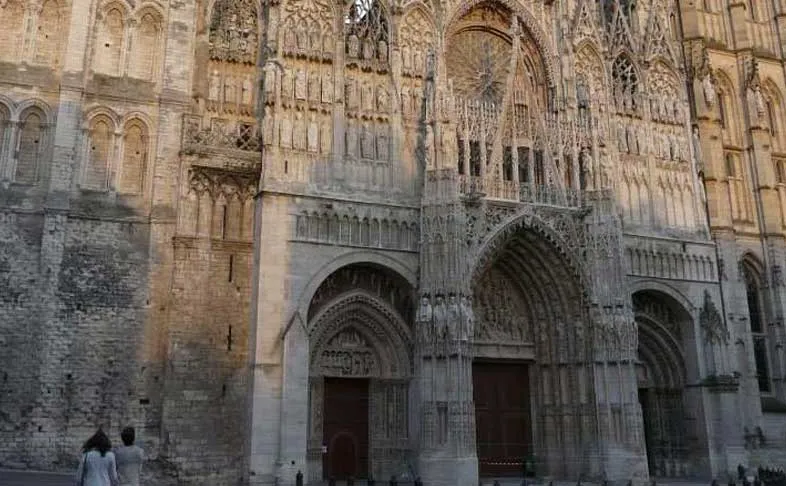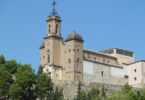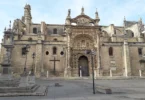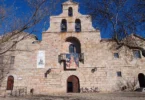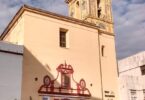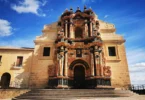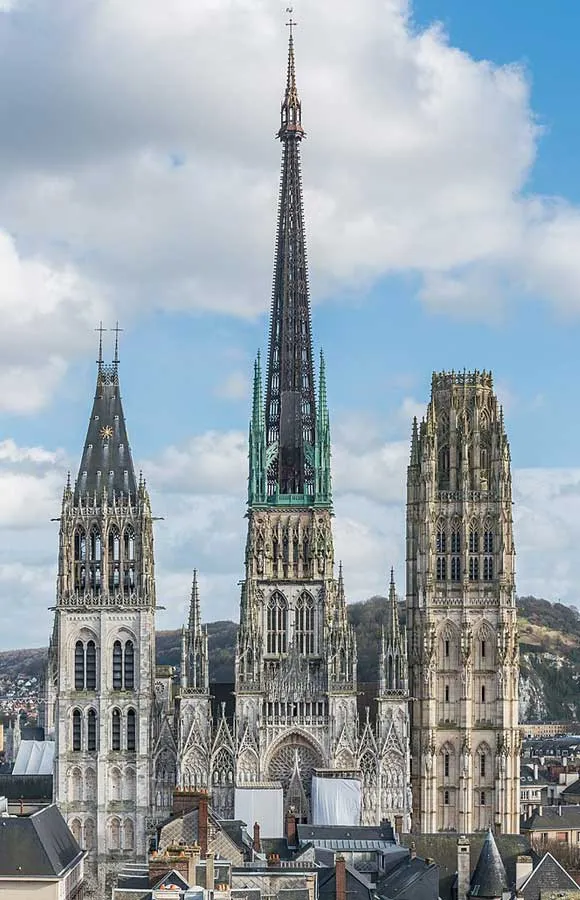
Introduction
Rouen Cathedral (French: Cathédrale primatiale Notre-Dame de l’Assomption de Rouen) is a Roman Catholic church in Rouen, Normandy, France. It is the see of the Archbishop of Rouen, Primate of Normandy. It is famous for its three towers, each in a different style. The cathedral, built and rebuilt over a period of more than eight hundred years, has features from Early Gothic to late Flamboyant and Renaissance architecture. It also has a place in art history as the subject of a series of impressionist paintings by Claude Monet.
Christianity was established in Rouen in about 260 by Saint Mellonius, who became the first bishop. The first church is believed to have been under or close to the present cathedral. In 395, a large basilica with three naves was built at the same site. In 755, the archbishop Rémy, the son of the Frankish statesman and military leader Charles Martel, established the first Chapter of the cathedral and constructed several courtyards and buildings around the church, including a palace for the archbishop.
The cathedral was enlarged by St. Ouen in 650, and visited by Charlemagne in 769. However, beginning in 841, a series of Viking raids seriously damaged the cathedral complex.
The Viking leader Rollo became first Duke of the Duchy of Normandy and was baptised in the Carolingian cathedral in 915 and buried there in 932. His grandson, Richard I of Normandy, further enlarged it in 950.
In the 1020s, the archbishop Robert began to rebuild the church in the Romanesque style, beginning with a new choir, crypt and ambulatory, and then a new transept. The Romanesque cathedral was consecrated by the archbishop Maurille on October 1, 1063, in the presence of William the Conqueror, not long before his conquest of England.
History of Cathédrale Notre-Dame de Rouen, France

The project for a cathedral in the new Gothic style was first launched by the Archbishop of Rouen, Hugues of Amiens, who had attended the consecration in 1144 of the Basilica of Saint-Denis, the first Gothic structure, with its emphasis upon filling the interior with light. In 1145, he began constructing a tower, now called the Tower Saint-Roman, in the new Gothic style.
A complete reconstruction of the cathedral was begun by his successor, Gautier the Magnificent in 1185 he demolished the Romanesque nave and began building the western end of the sanctuary. He had completed the west front and first traverses when the work was interrupted by a major fire on Easter eve in 1200, which destroyed a large part of the town and seriously damaged the unfinished church and its furnishings. Gautier quickly repaired the damage and resumed the work, which was directed by his master mason, Jean d’Andeli.
The nave was sufficiently complete by 1204 for King Philip II of France to be received there to celebrate the annexation of Normandy to the Kingdom of France. By 1207 the main altar was in place in the choir.
The first architectural addition to the new church was a series of small chapels between the buttresses on the north and south sides of the nave, requested by the city’s prominent religious brotherhoods and corporations. In 1280 the surrounding spaces and buildings were modified to permit the construction of portals on the north and south transepts.
The next addition was a response to the growing role of the Virgin Mary in church doctrine; the small axial chapel at the east end of the apse was replaced by a much larger chapel dedicated to her, begun in 1302. The west front was also given new decoration between 1370 and 1450. Beginning in 1468 a highly ornamental new top, made of iron and covered with stone tiles, in the late Gothic Flamboyant style was added to the tower of Saint-Romaine.
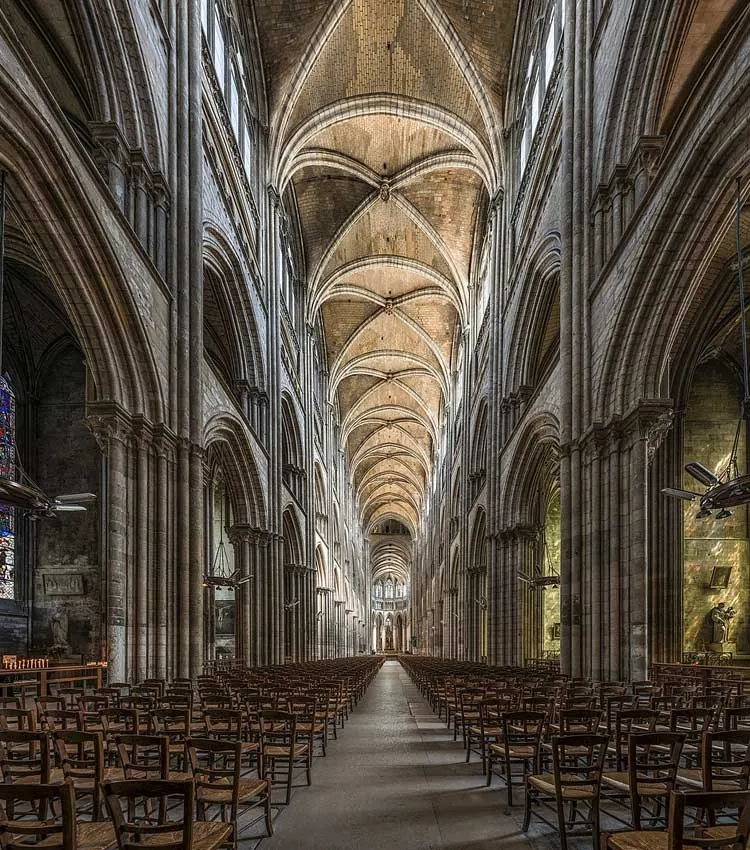
16th Century – The Transition and the Renaissance
Cardinal-Archbishop Georges d’Amboise (1494-1510) had a major influence on the church architecture. He incorporated into the Gothic design new Renaissance features, as he had done in his own residence, the Château de Gaillon, The first major project of the period was a new tower to match the old Saint-Romaine tower, built almost three centuries earlier.
Work on the tower had begun in 1488, under master builder Guillaume Pontifs, but under Cardinal d’Amboise in 1496 the project was taken over 1496 by Jacques Le Roux, who had a more ambitious plan with Renaissance touches. The Pope authorised Cardinal d’Amboise to grant dispensations to consume milk and butter during Lent, in exchange for contributions to the tower. The new tower soon took on the nickname of the Butter Tower, though the money collected paid only a portion of the cost.
As the new tower was being built, the west front of the Cathedral showed weaknesses and began to tilt. Cardinal d’Amboise ordered its complete reconstruction. This was carried out by master builder Rouilland Le Roux, nephew of Jacques Le Roux, in a lavishly ornate Flamboyant style. It was covered with layers of lacelike stone tracery, and hundreds of sculpted figures were added to the arch and niches of the portals.
To stabilise the new facade, he added two massive buttresses, also richly decorated with sculpture. In addition to his changes to the Cathedral, the Cardinal and his architect reconstructed and decorated the Palace of the Archbishop close by, adding a new reception hall, galleries, gardens and fountains.
In 1514 the flèche, or spire of the cathedral, a lead-covered wooden spire over the lantern tower, fell. It was replaced within a few months in exactly the same form and with the same materials.
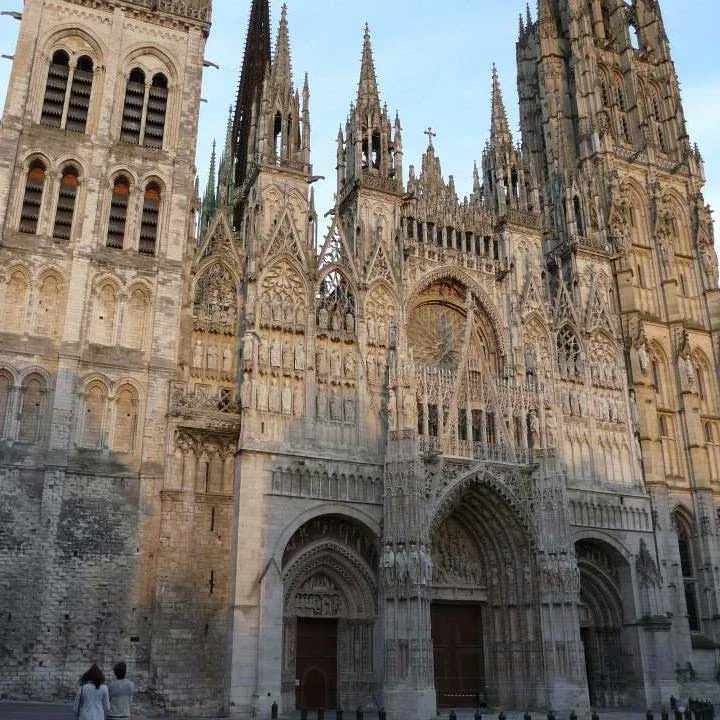
17th–18th Century
In the late 16th century the cathedral was badly damaged during the French Wars of Religion: in 1562 the Calvinists attacked the furniture, tombs, stained-glass windows and statuary. The cathedral was again struck by lightning in 1625 and 1642, then damaged by a hurricane in 1683. In 1796, in the course of the French Revolution, the new revolutionary government nationalised the cathedral and transformed it for a time into a Temple of Reason. Some of the furniture and sculpture was sold, and the chapel fences were melted down to make cannon.
19th Century
In 1822 lightning started a fire that destroyed the wood and lead Renaissance spire of the central tower. The architect Jean-Antoine Alavoine proposed to replace it with a new spire made of cast iron. The idea of an iron spire was highly controversial; the novelist Gustave Flaubert denounced it as “the dream of a metal-worker in a delirium.” The new spire, 151 meters (495 feet) tall, was not finally completed until 1882. For a short time, from 1876 to 1880, the spire made Rouen Cathedral the world’s tallest building, until the completion of Cologne Cathedral.
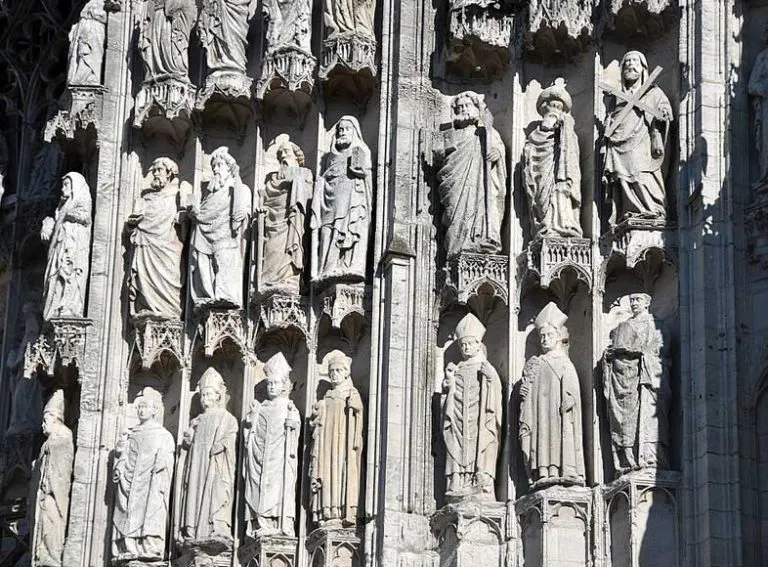
20th Century
In 1905, under the new law separating church and state, the Cathedral became the property of the French government, which then granted to the Catholic Church its exclusive use. At the beginning of World War II in 1939, remembering the damage caused to French cathedrals in World War I, the Cathedral authorities protected the sculpture of the cathedral with sandbags and removed the old stained glass and transported it to sites far from the city.
Nonetheless, in the weeks before D-Day in Normandy, the cathedral was hit twice by Allied bombs. In April 1944, seven bombs dropped by the British Royal Air Force hit the building, narrowly missing a key pillar of the lantern tower, and damaging much of the south aisle and destroying two windows. In June 1944, a few days before D-Day, bombs dropped by the U.S. Army Air Force set fire to the Saint-Romain tower. The bells melted, leaving molten remains on the floor.
Following World War II, a major restoration effort began to repair war damage by the Service of Historic Monuments, concluding in 1956. Then a new campaign began to consolidate the structure and to restore the statuary of the west front, including putting back four statues that had been moved elsewhere. In 2016, the project was finished and the scaffolding which had covered much of the cathedral for a half-century was finally removed.
Prior to the re-opening of the Cathedral in 1956, the choir, damaged by the bombing during the war, was given a substantial renewal. This included a new high altar topped by an 18th-century Rococo statue of Christ made of gilded made by Clodion, which had previously been on the altar screen, as well as new choir screens, a new episcopal throne, and a new communion table and pulpit made of cast iron and gilded copper.
Beginning in 1985, excavations were carried out beneath the church and its surroundings, which uncovered vestiges of the earlier Paleo christian buildings and foundations of the Carolingian cathedral. In 1999, during Cyclone Lothar, a copper-clad wooden turret, which weighed 26 tons, broke free from the tower and fell partly into the church, damaging the choir.
Exterior
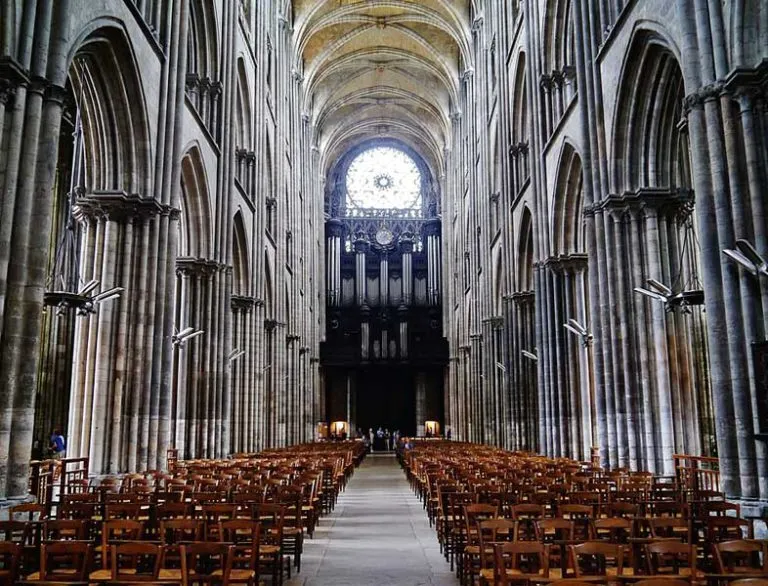
The west front of the Cathedral, with its three portals, is the traditional entrance to the Cathedral. The portals are aligned with the three aisles of the nave. The west front was first built in the 12th century, entirely redone in the 13th century, and then totally redone again at the end of the 14th century, each time become more lavishly decorated.
The main, or central portal, was originally dedicated to St. Romain in the 12th century, but was rededicated to the Virgin Mary when the facade was remade on a grander scale at the beginning of the 14th century. The central sculptural element of the tympanum, or arch over the portal, is a Tree of Jesse, a traditional depiction of the family tree of Christ. At the top is the Virgin Mary, with a halo of sun and stars. The arches above the tympanum of the portal are filled with sculpture of prophets, sibyls, or fortune-tellers, and patriarchs.
The portals on either side of the central portal followed the same format, with sculpture in the tympanum vividly illustrating Biblical stories. The portal to the of the central portal, facing the building, is dedicated to John the Evangelist, and the sculpture in the tympanum above illustrates the baptism of Christ, the passage of Saint John; the dance of Salome; the feast of Herod; and the beheading of John the Baptist. The portal to the right is devoted to Saint Stephen, and its sculpture illustrates the gathering of souls, Christ in majesty, and the stoning of Stephen. The portal to the Traces of pigment and gilding on the sculpture indicate that all the sculpture was originally brightly colored.
The towering buttresses on either side of the central portal were installed 14th century to strengthen the west front, and were covered with galleries of sculpture to merge them into the rest of the decoration.
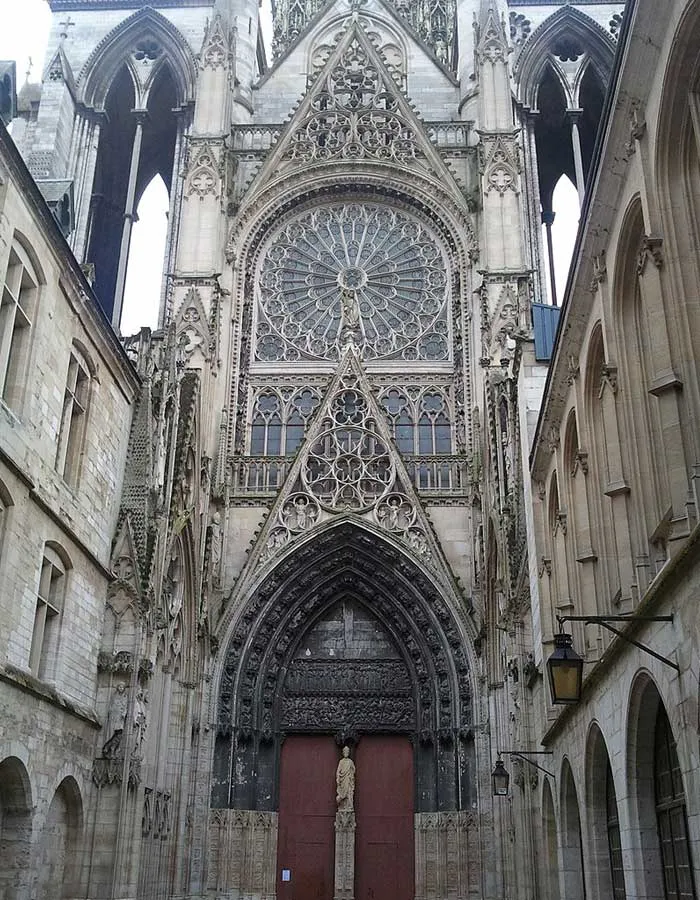
Saint-Romain Tower
The Saint-Romain tower, on the left facing the west front, was begun in 1145 as part of the original Gothic cathedral. The top of the tower, more decorative, was added in the 15th century. Like the Butter tower on the right side, it is separated from and slightly behind the main block of the west front.
The ground level has no windows, and contains the Baptistry. Above is a tall vaulted space with are four levels of bays, topped by a very ornate belfry. This contains the bourdon or largest Cathedral bell, named Joan of Arc, which weighs 9.5 tons. It also houses the sixty-four smaller bells of the carillon, which was restored in 2016. It is the second-largest carillon in France. The roof of the tower is decorated with sculptures of four small suns, made of gilded lead.
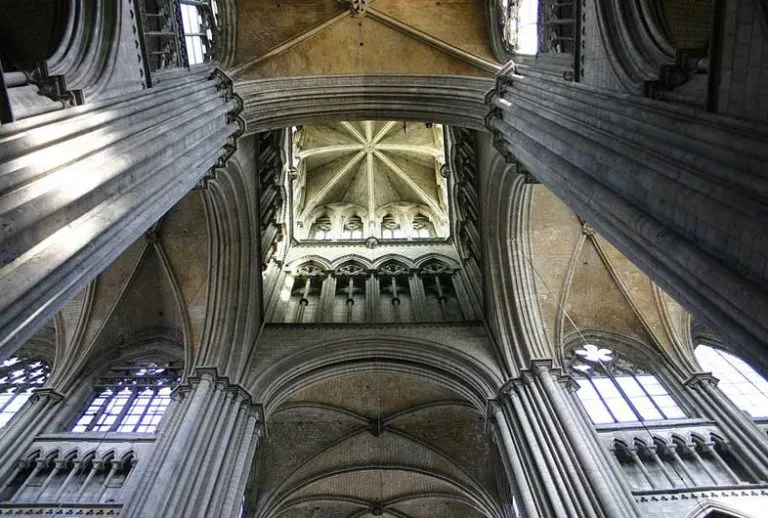
Butter Tower
The Butter Tower was constructed between 1488 and 1506, in a late Gothic Flamboyant style. It received its popular name because donors to the tower were given dispensation to consume butter and milk during Lent. The dense decoration of the tower emphasises its height; tall pointed niches for sculpture, buttresses decorated with tracery, pinnacles, gables and arches. At the top, the square plan of the tower becomes an octagon, with an ornate stone crown.
A bell for the Butter Tower, named George l’Amboise in honor of the Cardinal, was completed in 1501. It cracked in 1786 and was melted down during the French Revolution.

Lantern Tower and Spire
A central lantern tower over the transept is a tradition of Gothic architecture in Normandy. The lantern tower with its flèche, or spire is placed over the transept, almost in the centre of the cathedral, and is 151 meters high, the tallest of the three towers. The first two levels of the lantern tower. were built in the 13th century. The original Gothic spire was destroyed by fire in 1514, and rebuilt in 1544 in wood and lead by the master builder Robert Becquet. The next builder, Rouland Le Roux, consolidated the first two levels of the lantern tower and added flamboyant decoration and sculpture.
Another fire in 1822 destroyed the lead and wood spire, which was then replaced, after much controversy, by the architect Jean-Antoine Alavoine with a tower of iron and copper, finished in 1882. He surrounded the new spire with four smaller spires, made of copper. One of these fell during a hurricane in 1999, going through the roof and damaging the choir stalls below.

Tourelles and Sculpture Galleries
In the 13th century four smaller towers, or tourelles, with spires, were added atop the buttresses that were built to support the west front, two on either side of the central portal below. In the 14th century, to enrich the decoration even further, three gables were attached to the west front below each of the tourelles. The gables were filled with sculpture; over the north portal, statues of the first archbishops, apostles and saints, and on the south, kings and prophets from the Old Testament. They added another layer to the almost incredible complexity of the west front.
The Nave Exterior
Flying buttresses along the north and south sides of the cathedral reach up over the roof of the collateral aisles to support the upper walls of the nave. The space between the buttresses on the lower level is filled with collateral chapels. Thanks to the support of the buttresses, the upper walls of the nave are entirely filled with windows. The edges of the roof of the collateral aisles and of the nave are both lavishly decorated with balustrades and pinnacles. balancing the horizontal and vertical elements.
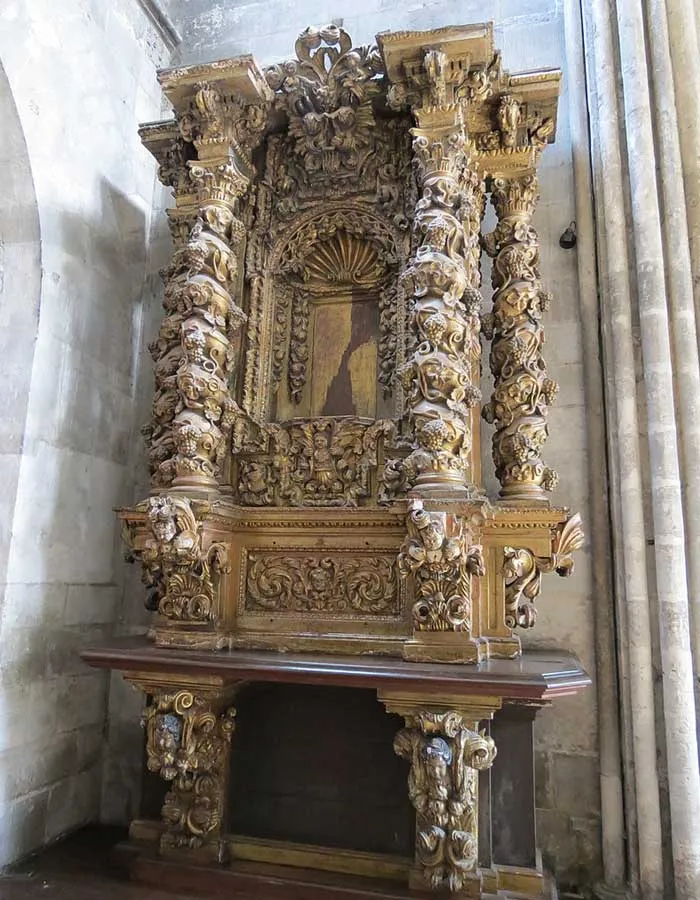
Chevet
The dominant feature of the Chevet, or east end of the Cathedral beyond the choir, is the chapel dedicated to the Virgin Mary, which extends well east of the choir and apse. It has very high buttresses, topped by pinnacles containing statues, and high lancet windows topped by gables, which are topped with statues. Above all these is the ‘Golden Virgin”, a gilded statue of The Virgin Mary made by Nicolas Quesnel in 1541.
Smaller chapels, accessed by the disambulatory, are fit between the buttresses north and south of the Virgin Mary Chapel. In addition, the Sacristy and the Revestiaire are attached to the south side of chevet.
Nave and Collateral Aisles
The nave is the portion of the cathedral where the churchgoers are seated, extending from the west front to the transept and choir. It is covered with four-part rib vaults, supported by colonettes with reach down the walls to the massive pillars on the ground floor.
The first four traverses of the nave, on the west, completed by 1200, followed the original elevation plan of the late 13th century; an arcade of pillars on the ground floor, which opened into the collateral aisles; above that a tribune, or wide passageway; above that the triforium, a narrow passageway; and above that the clerestory, the high windows which reached up into the arches of the vaults. All these levels provided the necessary width to support the upper walls.
After the fire of 1200, the master builder Jean d’Andeli began to revise the plans, following the design used in High Gothic cathedrals, which had only three levels. He made a compromise; he preserved the tribunes but he installed a narrow coursiere or passageway atop the arches of the tribune, which wound around the pillars.
He then made the arches of the tribune wider and taller, allowing more light from the windows of the collateral aisles to enter the nave. These modifications were possible thanks to another new technology, the flying buttress, which reaches over the collateral aisles provide to the upper nave walls, allowing them to be thinner and the windows to be larger.
The collateral aisles at Rouen are fourteen metres high compared with twenty-eight metres high vault in the nave. The high clerestory windows of the central nave look out over the roofs of the collateral aisles, and bring more light to the interior.
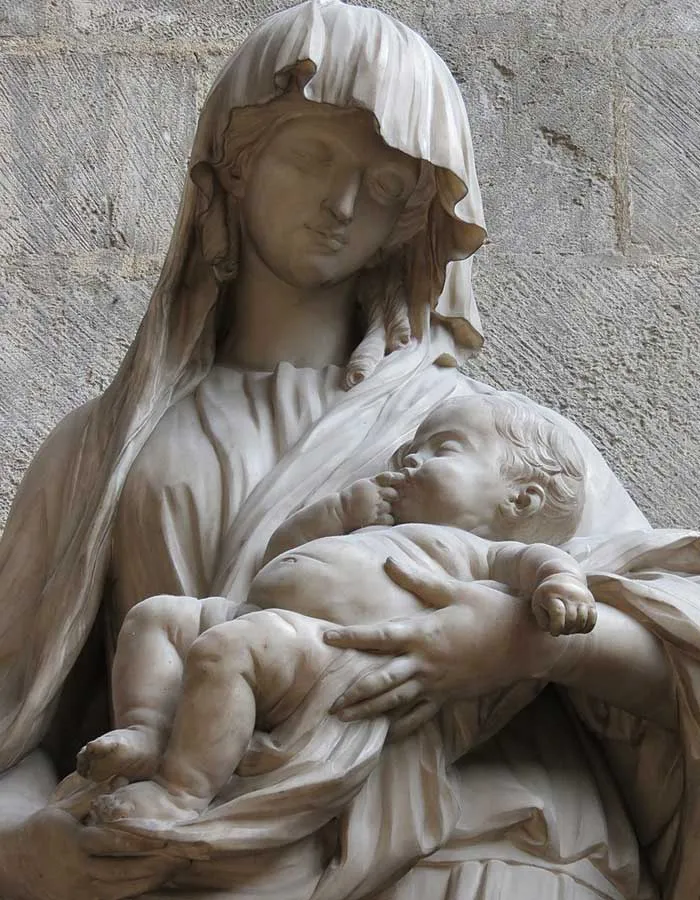
Transept
The transept is unusually large and brightly lit thanks to the large rose windows on the north and south and the large windows below them in the triforium of each transept. Overhead, the interior of the lantern tower is visible. The walls of the inside of the north and south facades are richly decorated with tracery, composed of pointed stone arches and sculpture in niches and in the small quadrille panels of the south transept. In the northwest corner is a stairway from 1471 which gave access to the cathedral library. It was updated with Neo-Gothic landings in the 18th century.
Choir
The Choir is the section of the cathedral at the east which was reserved for the clergy, and in the Middle Ages was separated from the nave by an elaborate screen. It was constructed slightly later than the nave, in the middle of the 13th century, and the style is more unified than in the nave. The beginning of the choir is marked by the retable of the main altar, and the throne of the Archbishop. Beyond that to the east are the stalls where the members of the clergy were seated.
The elevation of the Choir is different from that of the nave, being more in the High Gothic style of the 13th century, with three levels. The pillars of the arcade are circular, crowned with capitals decorated with stylised foliage and crochets. Above the arcade is the triforium, or enclosed gallery, and above that the high windows, which form a half-circle.
The center of the Choir was substantially refurbished before the 1956 re-opening to repair damage suffered during the war. The high altar was added, topped by an 18th-century Rococo statue of Christ made of gilded lead made by Clodion, which had previously been part of the 18th-century altar screen, as well as two kneeling angels, made by Caffieri in 1766, and previously in the Church of Saint-Vincent de Rouen, which was destroyed in 1944. The Choir also received modern screens by 20th-century artist Raymond Subes, a new episcopal throne, and a modern communion table and pulpit made of cast iron and gilded copper.
Stained Glass
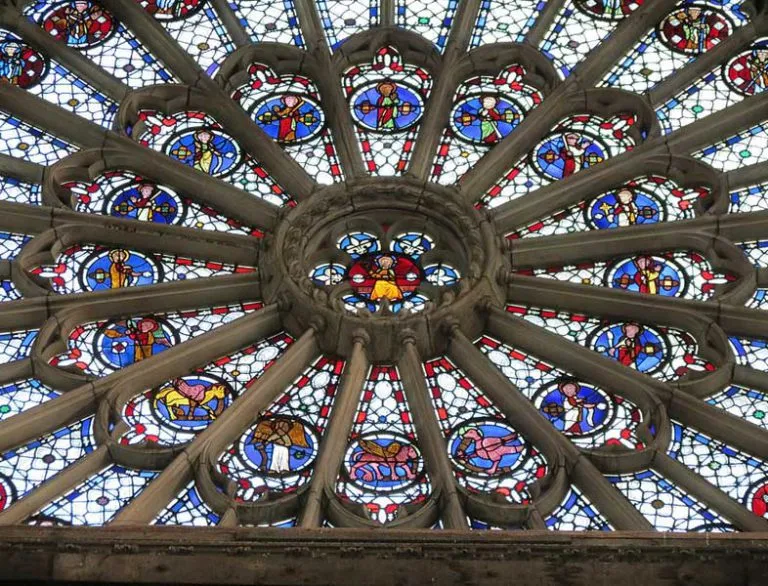
A considerable portion of the original stained glass from the 13th century is still in place. It dates from about the same time as the early windows of Chartres Cathedral and Bourges Cathedral. There are five bays with windows of early glass found in the collateral chapels of the north nave. The early windows are composed of series of medallions arranged in rows. Each medallion is made of small pieces of thick glass, deeply colored, particularly in reds and blues, bound together like mosaics with thin strips of lead.
Bells
The cathedral has seventy bells made by the Fonderie Paccard in Annecy. There are sixty-four in the Saint-Romain Tower and six in the Butter Tower. Together they are the heaviest “peal” or group of bells in France, with a combined weight of thirty-six tons.
Grand Organ
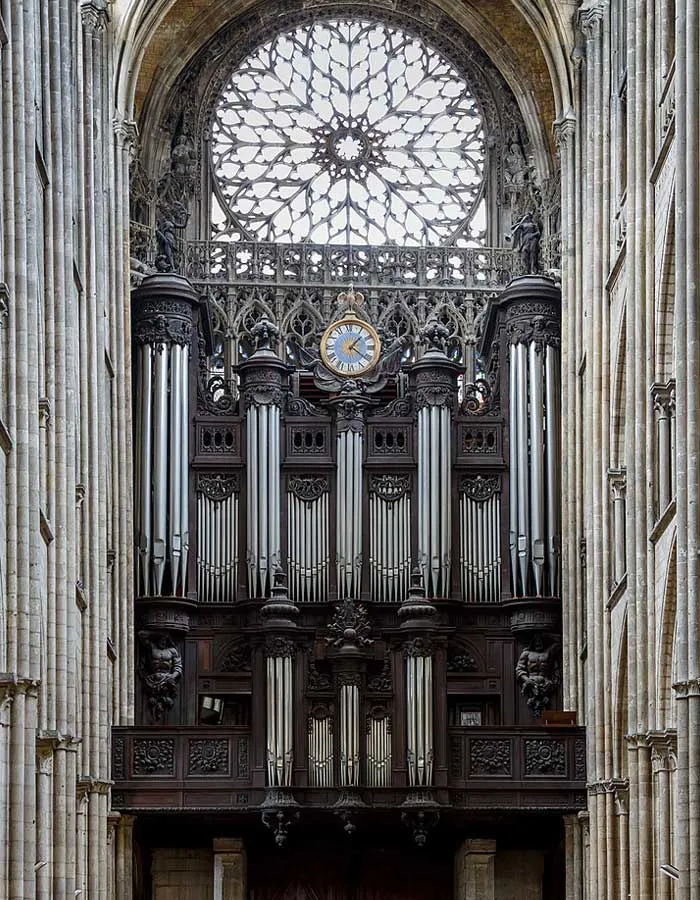
The cathedral had an organ since the 1380s. A larger new organ was constructed beginning in 1488, and placed at the beginning of the nave, on the inside of the west front under the rose window. This organ was damaged in the hurricane of 1683, but was put back into service. Prominent organists included Jean Titelouze from 1588 until 1634, and Jacques Boyvin from 1674 until 1706. A smaller organ had been installed in the choir in 1517, in the center of the Choir screen, removed during the Renaissance. New organs were built by Merklin & Schütze (1858–60) and, after World War II, by Jacquot-Lavergne.
Treasury
The treasury of the Cathedral was originally in the Sacristy, and then was moved to its own tower on the Alban Courtyard, on the north side of the cathedral. It was twice pillaged; first by the Protestants in 1562, then during the French Revolution in 1791. Most of the original objects were lost, with the exception of the Chasse de Saint-Roman, but in the 19th century, a new collection was assembled, acquired from monasteries, churches and private collections.
Notable objects include the Châsse de Saint Roman, a miniature cathedral made of gilded copper, with figures of Christ and the Apostles (late 13th century); the Châsse de Notre Dame, a mini-cathedral of gilded bronze and enamel, devoted to the Virgin Mary (19th century); A 15th-century monstrance, an elaborate miniature tower embracing a crystal cylinder used to hold the host during the Eucharist ceremony; and the Ostentoire of Two Crowns (1777), a similar vessel for the host, decorated with a gilded crown and rays of light. The treasury also displays some of the elaborate ceremonial costumes worn by the Archbishops.
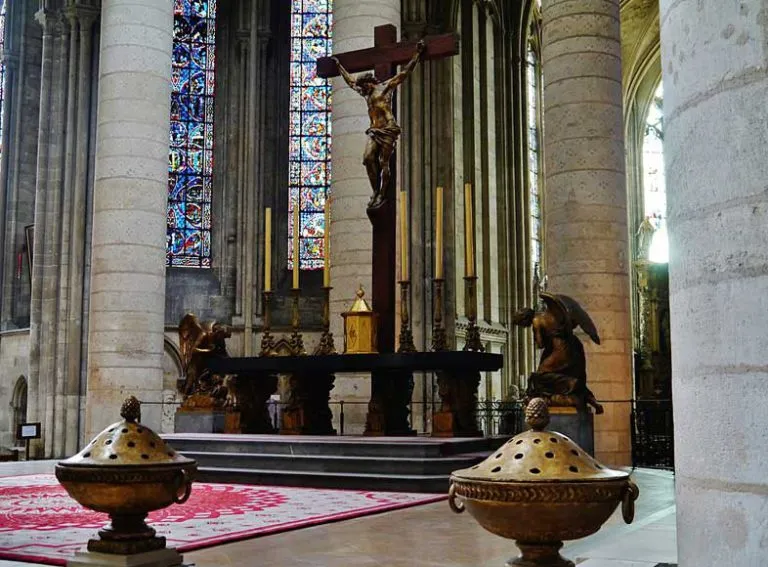
Crypt
The 11th-century crypt of the original Romanesque cathedral is located underneath the choir Gothic cathedral. It is accessed through the Chapel of Saint Joan of Arc on the south side of the Choir. It was excavated between 1931 and 1934, and opened to visitors in 1956. It was within the foundation of the old cathedral, and is composed of a sanctuary and a curving disambulatory with three small chapels, with vaults supported by two rows of columns. The original floor was made of a patter of made of light stone and black marble. There is well located in the disambulatory, beneath the axis of the apse above.
Feast Day - 12th August
Annual Feast Day of the Cathedral of Rouen, France (Our Lady of Rouen, France) celebrated on 12th August.
Mass Time
Tuesdays to Saturdays
Sundays
Church Visiting Time
Contact Info
3 rue Saint Romain,
76000, Rouen, France.
Phone No.
Tel : +33 2 35 71 85 65
Accommodations
How to reach the Cathedral
Rouen Airport or Aéroport de Rouen – Vallée de Seine is an airport located in Boos and 10 km southeast of Rouen in the Normandy région of France is the nearby Airport to the Cathedral.
Palais de Justice – Gisele Halimi Transit Stop in Rouen, France is the nearby Train Station to the Cathedral.

